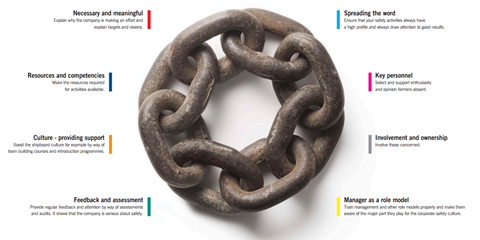
Why are there fewer work accidents within teams of people who have worked together for a long time? They might not have documented safety procedures that are consciously followed to the letter, but they seem to have an inherent understanding of what it takes to work together as a team. Whether they’re aware of it or not, people in such groups have all been part of creating a group culture – and a cornerstone of this culture is safety.
Safety is of paramount importance in the offshore wind energy sector. Everyone talks about it and many claim sufficient understanding of safety requirements. But, unfortunately, I believe there are several misconceptions about what this means.
More than procedures
One of those misconceptions concerns procedures. Having procedures in place doesn’t mean you have a robust safety framework. Procedures are no doubt important, but we need to bring safety up to a strategic level and into the culture of the organisation. Before thinking about the activities required to create a safe environment, we need to visualise the outcome.
That might appear to be easy: to create a safe environment to work in. But what exactly is a safe environment in the offshore wind industry? We can’t avoid that it is a physically demanding environment to work in.
Safety thinking needs to be applied to every situation offshore; not just in the big jobs such as replacing main turbine components. One recent incident comes to mind. A member of a group I was working with cut his finger quite seriously. We needed to prevent this from happening again, and an immediate solution was to demand that everyone wear cut gloves all the time. But this wasn’t practical because cut gloves would make dexterous work difficult.
So we realised that we had to step back and solve this together as a group by looking at the group’s behaviour and way of working. Together, the team conceptualised a solution involving using piping as a knife sheath. They then created the specifications and produced the sheaths themselves – and it’s been a successful, practical solution ever since.
What can we learn from this? Not just that the team solved an immediate problem in a practical way, but that everyone was involved in the process and believed it was a good solution. It added to the safety culture of the group.
A framework for developing safety culture
Taking this approach to safety, or any strategic initiative, is not easy, and it is helpful to look to proven strategic frameworks. One such framework relevant to the offshore wind industry is the ‘8 Safety Links’ developed by Seahealth Denmark. It encompasses a range of tools that help visualise and measure the strength of the organisation’s safety culture.
The 8 Safety Links guide you through a number of carefully structured questions that enable you to evaluate and measure the strategic safety competencies of the organisation.
Measuring competences can be subjective. For example, you need to score how well managers perform as safety role models. But the very process of evaluating and benchmarking performance will help bring safety into normal workplace conversations, which can only be a positive thing.
When the measurements in all of the eight criteria are complete, the results can then be visualise in a so-called ‘radar’ chart. This is a very useful way of representing conceptual data such that it can be communicated to people simply and quickly. I have worked within safety in the offshore industry for many years and I have not seen such an effective, yet simple way of measuring and visualising safety.
Promoting involvement
However, visualising the outcome is only one significant part of it. The process associated with 8 Safety Links means that everyone in the organisation is involved in the process. In order to analyse the safety culture, people need to share their stories and experience regarding safety. As for any strategic initiative, this is very important, as involvement is crucial to success.
Once the evaluation has been performed and you have a clear picture of the current state of the safety culture, you are well placed to create a suitable and realistic action plan. The 8 Safety Links provides a framework for doing this, too.
Applying these principles is an effective way to tackle safety issues and visualise realistic solutions with a lasting effect. And more importantly, you will have taken significant steps towards creating a group culture based on safety.
Find out more about the 8 Safety Links at SEAHEALTH.
